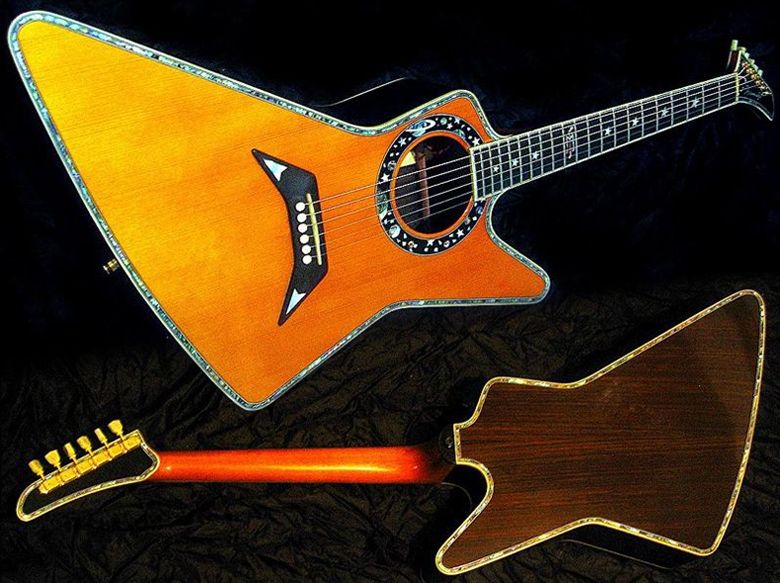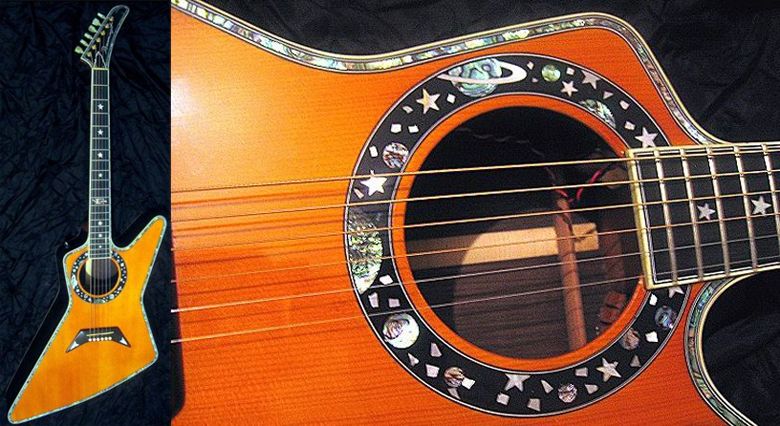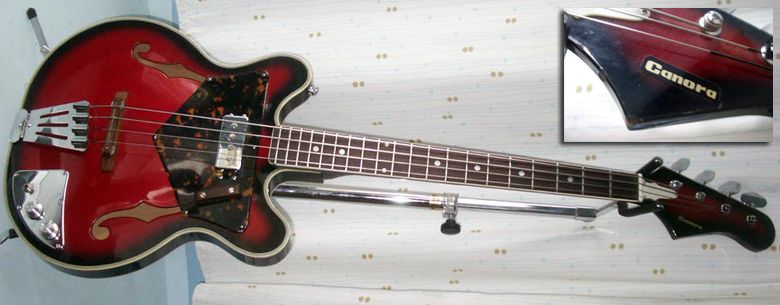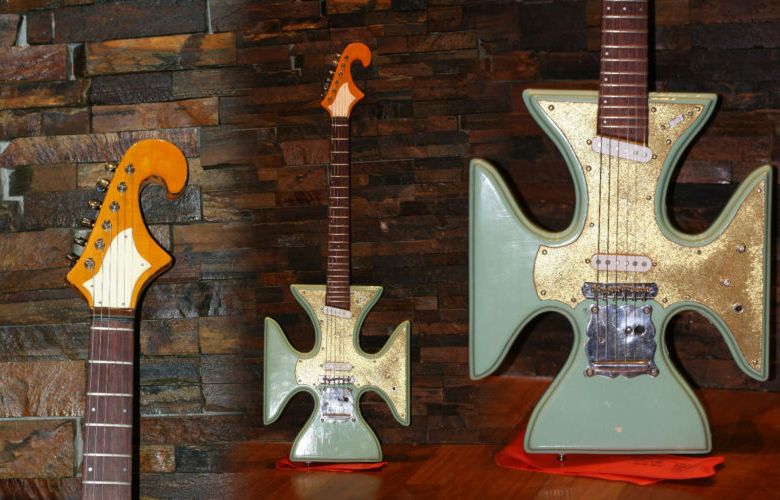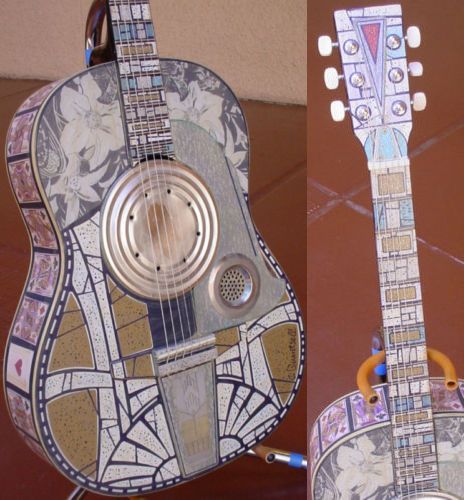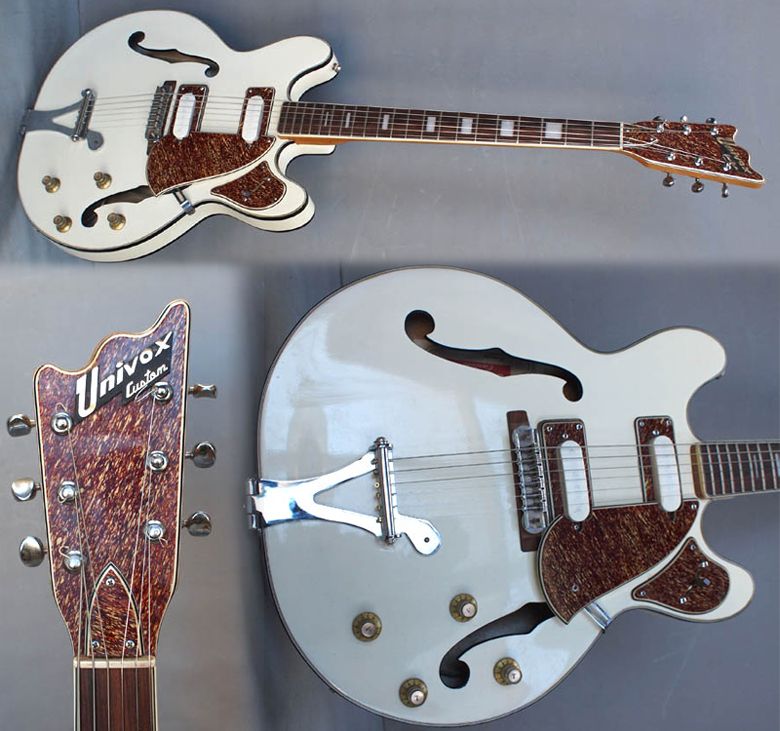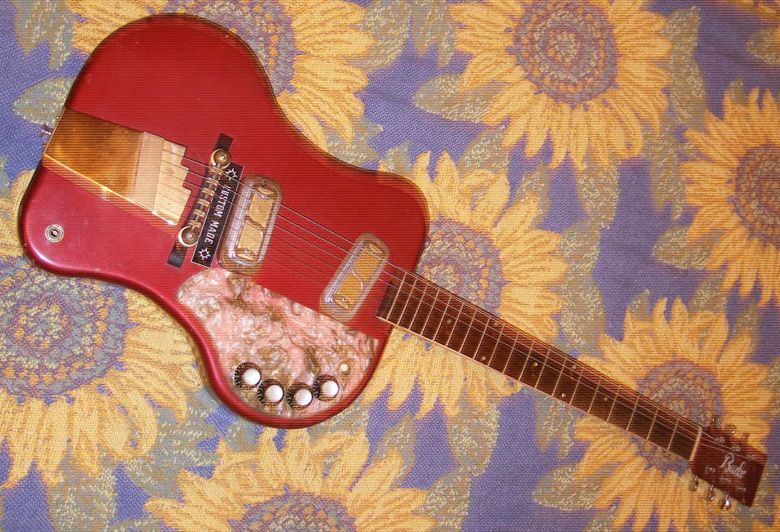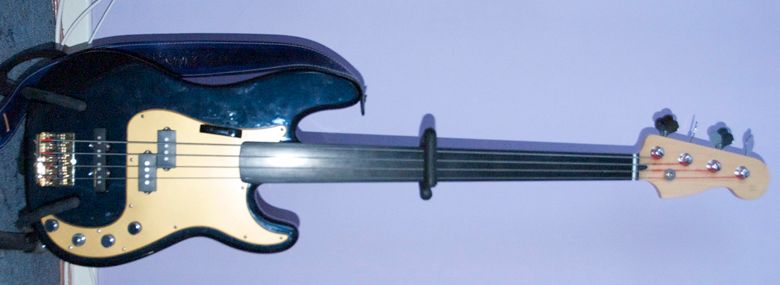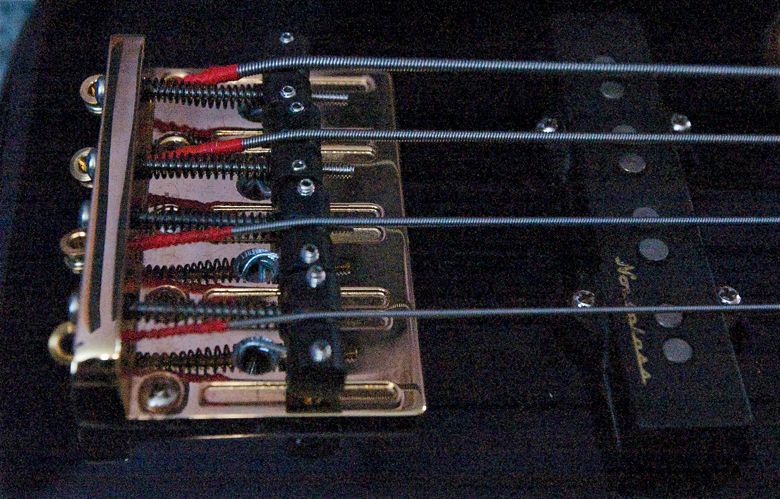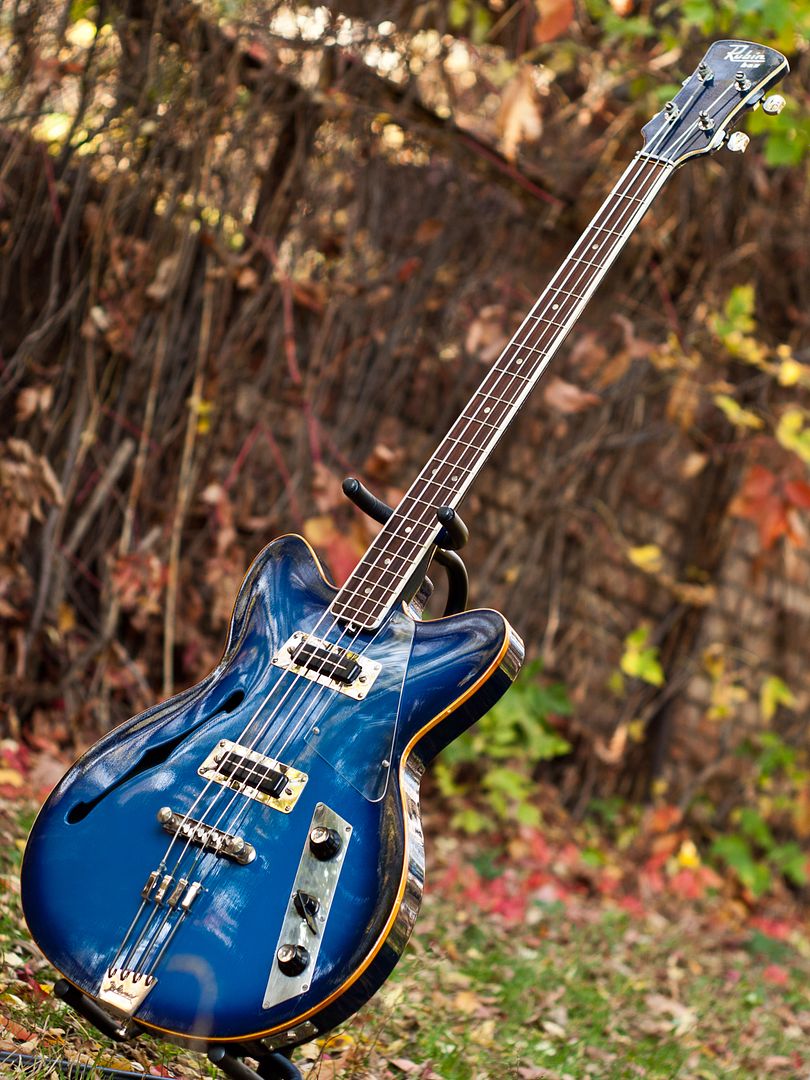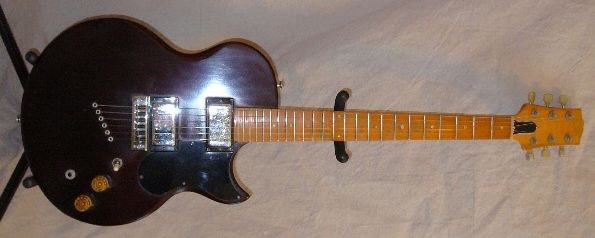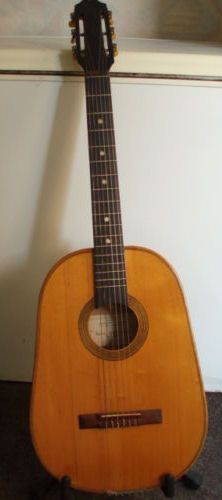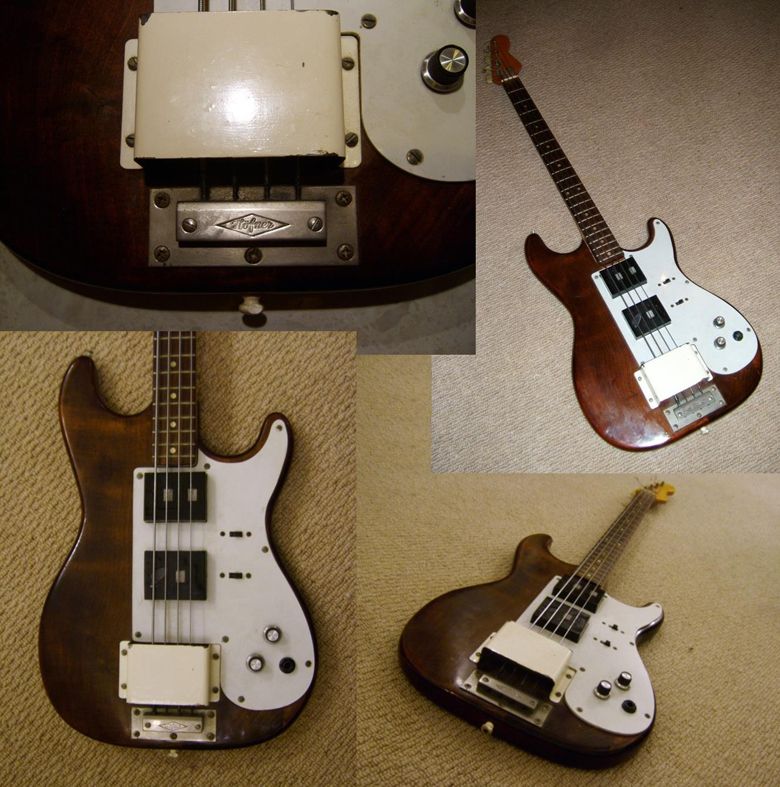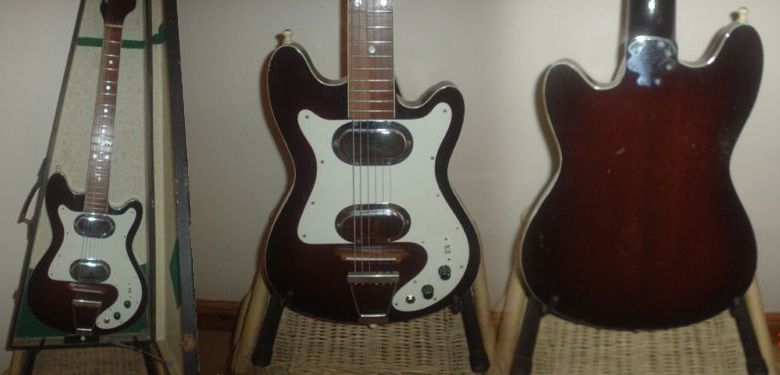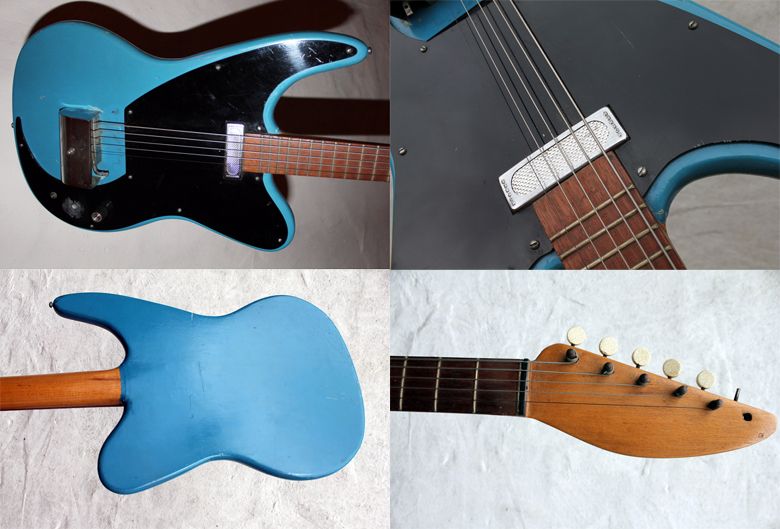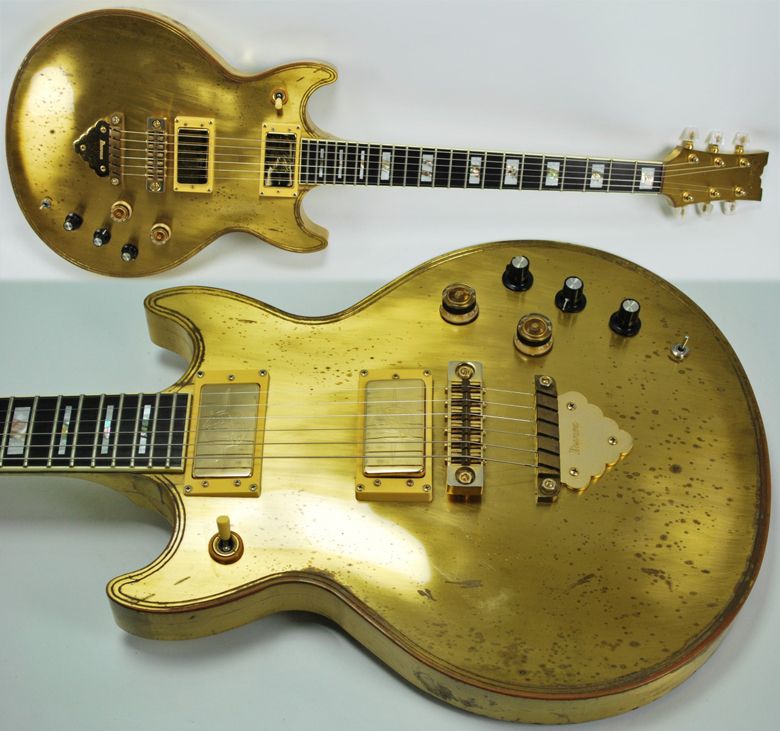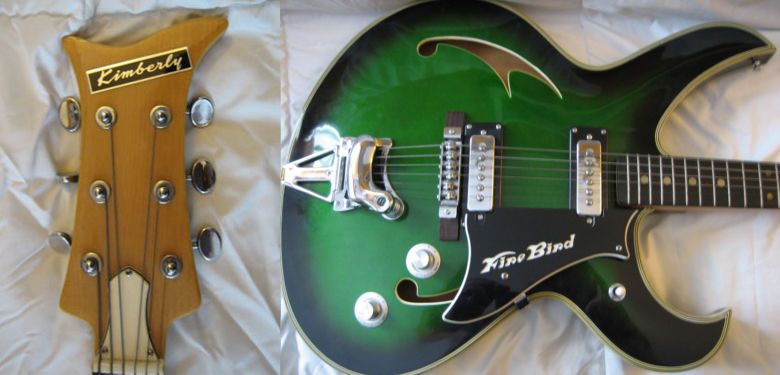guitarz.blogspot.com:
As played by Big Jim Sullivan.
Via Grégory Gutierez on the Guitarz Facebook page.
G L Wilson
© 2011, Guitarz - The Original Guitar Blog - now in its 10th year!
Monday, 31 October 2011
Vintage & Rare guitar of the week: Dommenget Maththias Jabs Acoustic Explorer
guitarz.blogspot.com:
This week our Guitar of the Week - chosen from the thousands of incredible instruments being sold via Vintage & Rare - is this quite stunning acoustic Explorer by Boris Dommenget as designed for Matthias Jabs of The Scorpions.
The guitar features a solid spruce top with back and sides of solid rosewood. Body binding on front and back is abalone and mother of pearl, and the intricate soundhole binding features stars and planets. The neck is Spanish cedar with ebony fretboard inlayed with star position markers. The headstock is the traditional Explorer shape and is fitted with Kluson tulip tuners. The scale length is a Fender-like 25.5" rather than the Gibson scale length of 24.75" that you might expect considering the design.
This guitar is being sold via Vintage & Rare priced at €7990.
Dommenget Guitars are based in Balje, Germany, and are best known for their various guitars built for German rock act The Scorpions. These have included acoustic Flying V guitars for Rudolf Schenker in 6-string, 12-string and doubleneck 12+6 models.
See also: Dommenget Guitars
G L Wilson
© 2011, Guitarz - The Original Guitar Blog - now in its 10th year!
This week our Guitar of the Week - chosen from the thousands of incredible instruments being sold via Vintage & Rare - is this quite stunning acoustic Explorer by Boris Dommenget as designed for Matthias Jabs of The Scorpions.
The guitar features a solid spruce top with back and sides of solid rosewood. Body binding on front and back is abalone and mother of pearl, and the intricate soundhole binding features stars and planets. The neck is Spanish cedar with ebony fretboard inlayed with star position markers. The headstock is the traditional Explorer shape and is fitted with Kluson tulip tuners. The scale length is a Fender-like 25.5" rather than the Gibson scale length of 24.75" that you might expect considering the design.
This guitar is being sold via Vintage & Rare priced at €7990.
Dommenget Guitars are based in Balje, Germany, and are best known for their various guitars built for German rock act The Scorpions. These have included acoustic Flying V guitars for Rudolf Schenker in 6-string, 12-string and doubleneck 12+6 models.
See also: Dommenget Guitars
G L Wilson
© 2011, Guitarz - The Original Guitar Blog - now in its 10th year!
Sunday, 30 October 2011
What guitar is Zaniboni playing in this video clip?
guitarz.blogspot.com:
Hey Tone! I reckon that's a Yamaha APX-T1, the travel-friendly model in Yamaha's acclaimed APX electro-acoustic series. Thanks for recommending the video; I enjoyed that! Maybe Bertram will be able to enlighten us as to what she's singing about.
G L Wilson
© 2011, Guitarz - The Original Guitar Blog - now in its 10th year!
Check out the guitar in this video.
Zaniboni is a French singer. I love her guitar - so small and well-designed. A cute little acoustic. Plus she's a great singer and guitarist. I have no idea what she's singing! Thanks for the help!
Tone Deaf Radio!
Hey Tone! I reckon that's a Yamaha APX-T1, the travel-friendly model in Yamaha's acclaimed APX electro-acoustic series. Thanks for recommending the video; I enjoyed that! Maybe Bertram will be able to enlighten us as to what she's singing about.
G L Wilson
© 2011, Guitarz - The Original Guitar Blog - now in its 10th year!
Canora vintage Japanese semi-hollowbody bass guitar
guitarz.blogspot.com:
Here's a 1960s Japanese-made Canora semi-hollowbody bass. Anyone out there heard of the Canora brand? It appears to be the same model as the Sekova Vulcan and very likely was available under other brandnames too.
The eBay seller makes some really interesting observations:
This is not a modern-sounding bass. It has that 50s/60s boom to it - as would would expect from a short scale bass with a single pickup mounted in the neck position - but it would probably be invaluable for re-creating that vintage vibe should you desire to do so.
Currently listed on eBay with bidding at $235.50 at the time of writing, and over 2 days left before the end of the auction.
G L Wilson
© 2011, Guitarz - The Original Guitar Blog - now in its 10th year!
Here's a 1960s Japanese-made Canora semi-hollowbody bass. Anyone out there heard of the Canora brand? It appears to be the same model as the Sekova Vulcan and very likely was available under other brandnames too.
The eBay seller makes some really interesting observations:
While it is nearly impossible to exactly pinpoint the manufacturer of this bass, it is clearly an early product of Matsumoku, Kawai and the Teisco guitar factories as it has recognizable parts from each of those plants. It is well known that Matsumoku kept very poor records on the export models they produced, but it is known all of the Univox, Aria, and Guyatone guitars came from them as well as some Ibanez, Electra, Yamaha and dozens of other brands had at least a foothold in production there. It was clearly an odd time unlike anything that happens at US factories, because you'd often see different combinations of factories necks, bodies, pickups, and hardware all on the same guitar. Imagine a Fender neck on a Mosrite body with Gibson pickups and you get the idea of where I am going with this. It seems very strange but I think it went to a different sensibility employed in designing this guitars. There were a lot of orders to fill and many more coming down the pike! It seems that for the lines made for the Japanese market this was less the case, but the US imports often became a free for all. What results is many models with confusing slight or drastic variations in design that has made it almost impossible to get a solid handle on it. The guitars like Kent, Decca, Kingston, Guyatone, Audition, Lyle, and Melody all seem to morph and change model to model and year to year in this way. It is clearly not very easy for me to say with certainty much else about the history of this model...The seller also tells us that the design is based on that of the Gibson EB-2. Personally, I'd have said that there was more of a hint of Kay going on in there. And where have I seen that shield-shaped pickguard before?
This is not a modern-sounding bass. It has that 50s/60s boom to it - as would would expect from a short scale bass with a single pickup mounted in the neck position - but it would probably be invaluable for re-creating that vintage vibe should you desire to do so.
Currently listed on eBay with bidding at $235.50 at the time of writing, and over 2 days left before the end of the auction.
G L Wilson
© 2011, Guitarz - The Original Guitar Blog - now in its 10th year!
Saturday, 29 October 2011
Maltese Cross guitar from Madrid in the style of Harvey Thomas
guitarz.blogspot.com:
I got quite excited just now when I saw that this Maltese Cross guitar had just been listed on eBay UK with a starting price of £300. Then when I looked closer at the listing I saw that it was a copy built by a Spanish luthier and was not an original by eccentric American luthier Harvey Thomas. The Thomas Maltese Cross guitar was, of course, famously played by Ian Hunter of Mott the Hoople (see this blog post for more).
This guitar features maple body and neck with a relic nitro finish, two handwound Strat-type single coil pick-ups with Alnico V magnets, metal dot markers (the orignal Thomas Maltese Cross had cross-shaped markers), a light German carve to the body, and headstock binding.
Alas the guitar needs some work doing to it as the tremolo is said to be "not working" (who knows what that means, it might just need an arm, or it might need more attention), and control knobs are missing.
G L Wilson
© 2011, Guitarz - The Original Guitar Blog - now in its 10th year!
I got quite excited just now when I saw that this Maltese Cross guitar had just been listed on eBay UK with a starting price of £300. Then when I looked closer at the listing I saw that it was a copy built by a Spanish luthier and was not an original by eccentric American luthier Harvey Thomas. The Thomas Maltese Cross guitar was, of course, famously played by Ian Hunter of Mott the Hoople (see this blog post for more).
This guitar features maple body and neck with a relic nitro finish, two handwound Strat-type single coil pick-ups with Alnico V magnets, metal dot markers (the orignal Thomas Maltese Cross had cross-shaped markers), a light German carve to the body, and headstock binding.
Alas the guitar needs some work doing to it as the tremolo is said to be "not working" (who knows what that means, it might just need an arm, or it might need more attention), and control knobs are missing.
G L Wilson
© 2011, Guitarz - The Original Guitar Blog - now in its 10th year!
Moll Express jazz guitar
Though it has an old school/modernist German vibe, this superb high end luthier's jazz guitar comes from Missouri (I think it's one of the states of Northern America). Its slightly experimental shape - based on ageless hollow-body template - combines venerability and sexiness, how can one not love it?
There are also plenty of lovely details on this Moll Express - the ebony stop-tail with moon and stars inlays, the asymmetric bridge, the knobs on the scratchplate (I feel like writing scratchplate today and not pickguard), the wide soundholes, the fingerboard mother-of-pearl inlays, the headstock shape... A guitar I wouldn't abuse!
© 2011, Guitarz - The Original Guitar Blog - now in its 10th year!
Friday, 28 October 2011
Antique vintage tenor guitar banjo uke banjitar - handmade and possibly unique?
guitarz.blogspot.com:
Here's another instrument that looks to be a handmade one-off, although a lot more craftsmanship has gone into creating this than on the boat oar guitar we saw in the previous blog post here on Guitarz.
I'm not sure what instrument the maker thought they were building here, but for our purposes I think it's safe to call it a cross between a tenor guitar, a tenor banjo and a baritone ukulele. The headstock style is very banjo-like, as is the general shape, but the all-wooden construction and soundhole are more guitar- and/or ukulele-like. The scale length is 21 1/2" which is more akin to a tenor guitar or banjo than it is to a baritone uke, but I guess it's up to the player to decide how to tune it and play it. I do like the hexangonal shape at the back of the body. If you've ever tried playing a banjo you'll know that a round body is not the best shape for playing when seated; I'm sure a hexagon-shaped instrument isn't going to slip as easily.
It does need some minor repair work doing to it, but with a starting price of $0.99 on eBay it could provide a nice little project for someone which is unlikely to break the bank.
G L Wilson
© 2011, Guitarz - The Original Guitar Blog - now in its 10th year!
Here's another instrument that looks to be a handmade one-off, although a lot more craftsmanship has gone into creating this than on the boat oar guitar we saw in the previous blog post here on Guitarz.
I'm not sure what instrument the maker thought they were building here, but for our purposes I think it's safe to call it a cross between a tenor guitar, a tenor banjo and a baritone ukulele. The headstock style is very banjo-like, as is the general shape, but the all-wooden construction and soundhole are more guitar- and/or ukulele-like. The scale length is 21 1/2" which is more akin to a tenor guitar or banjo than it is to a baritone uke, but I guess it's up to the player to decide how to tune it and play it. I do like the hexangonal shape at the back of the body. If you've ever tried playing a banjo you'll know that a round body is not the best shape for playing when seated; I'm sure a hexagon-shaped instrument isn't going to slip as easily.
It does need some minor repair work doing to it, but with a starting price of $0.99 on eBay it could provide a nice little project for someone which is unlikely to break the bank.
G L Wilson
© 2011, Guitarz - The Original Guitar Blog - now in its 10th year!
3-string boat oar guitar
guitarz.blogspot.com:
Do you really need me to write an in-depth blog post about this boat oar guitar? It's a boat oar, strung up with three strings and with a pickup mounted on it, and would be used for sldie playing in cigar box star style.
Currently listed on eBay with a starting price of $100 for those who don't want to be bothered with building something similar themselves.
See also the Tennis Racquet Guitar.
G L Wilson
© 2011, Guitarz - The Original Guitar Blog - now in its 10th year!
Do you really need me to write an in-depth blog post about this boat oar guitar? It's a boat oar, strung up with three strings and with a pickup mounted on it, and would be used for sldie playing in cigar box star style.
Currently listed on eBay with a starting price of $100 for those who don't want to be bothered with building something similar themselves.
See also the Tennis Racquet Guitar.
G L Wilson
© 2011, Guitarz - The Original Guitar Blog - now in its 10th year!
Thursday, 27 October 2011
BC Rich NJ Series Made In Japan electro-acoustic jazz guitar
guitarz.blogspot.com:
B.C. Rich's NJ Series replaced the B.C. Rico brandname that originally appeared on their Japanese-made instruments and which had been the subject of a lawsuit from the Rico Reed Company. Although the initials NJ stood for "Nagoya, Japan" where the first NJ instruments were built, later Korean-made guitars also received the NJ Series designation.
This B.C. Rich NJ Series electro-acoustic jazzer, reminiscent in some ways of Gibson's Howard Roberts model, is a Japanese-made example which the seller claims was made by the Daion company. (Check here for other Daion guitars that we have looked at previously here on Guitarz). Daion guitars were manufactured from the lates 1970s through to 1984 by the Japanese company Yamaki, so I guess that it was this same company who built these B.C. Rich models rather than Daion specifically.
The guitar features a humbucker pickup at the neck plus a piezo in the bridge, controlled via volume and tone pots for each and a 3-way pickup selector switch all boldy mounted on top of the guitar. The soundhole is a suitably angular shape considering the brand, as is the sharp Florentine cutaway. The heel of the neck is comfort contoured so as to facilitate playing at the top of the neck.
This guitar is currently being offered for same on eBay UK (although the item is actually located in Sweden) with a starting price of £599.99 and a Buy It Now price of £999.99.
G L Wilson
© 2011, Guitarz - The Original Guitar Blog - now in its 10th year!
B.C. Rich's NJ Series replaced the B.C. Rico brandname that originally appeared on their Japanese-made instruments and which had been the subject of a lawsuit from the Rico Reed Company. Although the initials NJ stood for "Nagoya, Japan" where the first NJ instruments were built, later Korean-made guitars also received the NJ Series designation.
This B.C. Rich NJ Series electro-acoustic jazzer, reminiscent in some ways of Gibson's Howard Roberts model, is a Japanese-made example which the seller claims was made by the Daion company. (Check here for other Daion guitars that we have looked at previously here on Guitarz). Daion guitars were manufactured from the lates 1970s through to 1984 by the Japanese company Yamaki, so I guess that it was this same company who built these B.C. Rich models rather than Daion specifically.
The guitar features a humbucker pickup at the neck plus a piezo in the bridge, controlled via volume and tone pots for each and a 3-way pickup selector switch all boldy mounted on top of the guitar. The soundhole is a suitably angular shape considering the brand, as is the sharp Florentine cutaway. The heel of the neck is comfort contoured so as to facilitate playing at the top of the neck.
This guitar is currently being offered for same on eBay UK (although the item is actually located in Sweden) with a starting price of £599.99 and a Buy It Now price of £999.99.
G L Wilson
© 2011, Guitarz - The Original Guitar Blog - now in its 10th year!
Wednesday, 26 October 2011
G L Stiles vintage guitar from another of America's almost forgotten luthiers
guitarz.blogspot.com:
Here's another rare G L Stiles guitar with its distinctive scrolled body horns and intricate headstock carving. Gilbert Lee Stiles built a number of essentially one-off guitars from his workshop in Miami, Florida during the 1960s and 1970s. This particular example is thought to be from the early 60s (according to the seller) and features a pair of DeArmond pickups and an attractive checkerboard binding around the top and rear of the body and the neck.
These rare guitars do not come up for sale very often. This example is currently listed on eBay with a Buy It Now price of $2,400.
For more G L Stiles guitars see here and here.
G L Wilson
© 2011, Guitarz - The Original Guitar Blog - now in its 10th year!
Here's another rare G L Stiles guitar with its distinctive scrolled body horns and intricate headstock carving. Gilbert Lee Stiles built a number of essentially one-off guitars from his workshop in Miami, Florida during the 1960s and 1970s. This particular example is thought to be from the early 60s (according to the seller) and features a pair of DeArmond pickups and an attractive checkerboard binding around the top and rear of the body and the neck.
These rare guitars do not come up for sale very often. This example is currently listed on eBay with a Buy It Now price of $2,400.
For more G L Stiles guitars see here and here.
G L Wilson
© 2011, Guitarz - The Original Guitar Blog - now in its 10th year!
So-called Art Deco resonator guitar with over-the-top finish and baked bean can detail
guitarz.blogspot.com:
There's no denying that the artwork on this old acoustic guitar (a so-called "Customised Resonator Guitar" even) has been beautifully executed. It is supposedly Art Deco inspired, although I think it is rather too busy to fit in faithfully with that genre. The playing cards around the sides of the guitar are really one step too far and lend it a tacky Las Vegas look rather than one of sophistication which I believe was the desired effect.
What really spoils it is the base from a catering-size tin of baked beans that has been inset where the soundhole once inoffensively appeared. I usually try not to sink to lowest common denominators when describing guitars like this, but in this instance all I can think to say is that it looks crap. Pairing this with a second soundhole insert, quite obviously a strainer intended to sit over the plughole in the kitchen sink, does nothing to help matters. Yes, by all means use these elements on cigar box guitars; they seem to make some sense there and indeed are part of the charm of such instruments. But on an instrument that is trying to look sophisticated, such elements could not be more out of place.
Furthermore, shoving the bottom of a baked bean tin into the top of your guitar will not magically transform it into a resonator. The spun aluminium cone of a resonator guitar is a fine piece of precision engineering. Its function cannot be replicated with the bottom of a bean tin with a few holes punched in it. All that is going to do is to create a few more spurious vibrations and cause the guitar to rattle.
You might consider this a nice example of a piece of folk art and that the Buy It Now price of £270 would be money well spent, but personally I'd give it a miss. If it does actually sound any good, it'll be by accident rather than design. Note that in the YouTube video showing the guitar, the video finishes just before the guitar is about to get played. That alone speaks volumes!
G L Wilson
© 2011, Guitarz - The Original Guitar Blog - now in its 10th year!
There's no denying that the artwork on this old acoustic guitar (a so-called "Customised Resonator Guitar" even) has been beautifully executed. It is supposedly Art Deco inspired, although I think it is rather too busy to fit in faithfully with that genre. The playing cards around the sides of the guitar are really one step too far and lend it a tacky Las Vegas look rather than one of sophistication which I believe was the desired effect.
What really spoils it is the base from a catering-size tin of baked beans that has been inset where the soundhole once inoffensively appeared. I usually try not to sink to lowest common denominators when describing guitars like this, but in this instance all I can think to say is that it looks crap. Pairing this with a second soundhole insert, quite obviously a strainer intended to sit over the plughole in the kitchen sink, does nothing to help matters. Yes, by all means use these elements on cigar box guitars; they seem to make some sense there and indeed are part of the charm of such instruments. But on an instrument that is trying to look sophisticated, such elements could not be more out of place.
Furthermore, shoving the bottom of a baked bean tin into the top of your guitar will not magically transform it into a resonator. The spun aluminium cone of a resonator guitar is a fine piece of precision engineering. Its function cannot be replicated with the bottom of a bean tin with a few holes punched in it. All that is going to do is to create a few more spurious vibrations and cause the guitar to rattle.
You might consider this a nice example of a piece of folk art and that the Buy It Now price of £270 would be money well spent, but personally I'd give it a miss. If it does actually sound any good, it'll be by accident rather than design. Note that in the YouTube video showing the guitar, the video finishes just before the guitar is about to get played. That alone speaks volumes!
© 2011, Guitarz - The Original Guitar Blog - now in its 10th year!
Tuesday, 25 October 2011
Vintage 60s super rare, Super Astrotone, super surf style retro Japanese guitar
guitarz.blogspot.com:


The title of this one alone, made me out of breath.
The seller of this fabulous beast has given an equally breathless description, starting by repeating the headline, as follows:
The seller of this fabulous beast has given an equally breathless description, starting by repeating the headline, as follows:
VINTAGE 60S SUPER RARE, SUPER ASTROTONE, SUPER SURF STYLE RETRO JAPANESE GUITAR.
This beauty features a solid mahogany body that has two chrome single coil pickups, two volume, one tone controls, two rocker style pickup selector switches, and a rhythm/solo switch, all on a highly polished chrome pickguard. The adjustable bridge is missing the saddle, but it should be very easy to find a replacement here on ebay. The tuners are not original, and should be changed. They are in working condition, but they are not in line 6 tuners, and the 3rd is overlapping onto the 4th. It has a very resposive tremolo with the original arm and chrome tremolo cover. The adjustable neck is solid mahogany, has 20 frets on the rosewood fretboard with barely any noticable wear on the fretboard or frets. Has some very minor scuffs, scratches, dings and dents typical of a 45 year old guitar and is in especially good condition.
This is one super rare guitar, and is the fourth super Astrotone I've owned, and without a doubt, in the finest condition. It's survived the 70s, 80s, & 90s probably in someone’s attic or locked away in a closet. This is one awesome Japanese model, and with those horns, one of the coolest surf style guitars on the planet!
Snatch & grab it for $399
Note; I re-wrote this a little (taking out the every-word capitalisation and &s everywhere) to make it easier on the eye. [...and I removed a few spurious apostrophes - GLW].
This is a super looking guitar with some nice unique features but $400 for what is really a project guitar, with some issues, does seem a bit hopeful
This is a super looking guitar with some nice unique features but $400 for what is really a project guitar, with some issues, does seem a bit hopeful
David in Barcelona
© 2011, Guitarz - The Original Guitar Blog - now in its 10th year!
1990s Abel Axe aluminium-bodied electric and shot full of holes!
guitarz.blogspot.com:
The Abel Axe is an American-made guitar designed by Jeff Abel in the mid 1990s, produced between 1994 and 1996. The guitar features a small vaguely Strat-like body which has been made from a single piece of T6 aluminium billet, but what makes it really stand out is that the body is peppered full of holes. Whilst these holes lend the guitar a certain aesthetic, they are not there for appearances alone; they also serve to reduce the body mass and take a few pounds off the weight.
This particular Abel Axe currently being auctioned on eBay weighs in at 9.5lbs. Pickups on this example are a pair of humbuckers; a Kent Armstong HRE-1 in the neck position and a Kent Armstrong HSDE-1 at the bridge. Up at the headstock we have Spurzel locking tuners nicely finished in purple to complement the body, while at the other end the bridge is a hardtail unit, although some Abel Axes were fitted with a Kahler tremolo.
The seller says that the sustain goes on forever, and whilst the cynical amongs us would be of the opinion that "Of course he'd say that!", in this case - considering the body material - I can well believe it.
It's said that there were only 200 of these guitars built, so this is a quite a rare piece. The auction on eBay opened with a starting bid of $0.99 although there is a reserve placed on the guitar. I'll be watching with interest to see what the final price will be.
G L Wilson
© 2011, Guitarz - The Original Guitar Blog - now in its 10th year!
The Abel Axe is an American-made guitar designed by Jeff Abel in the mid 1990s, produced between 1994 and 1996. The guitar features a small vaguely Strat-like body which has been made from a single piece of T6 aluminium billet, but what makes it really stand out is that the body is peppered full of holes. Whilst these holes lend the guitar a certain aesthetic, they are not there for appearances alone; they also serve to reduce the body mass and take a few pounds off the weight.
This particular Abel Axe currently being auctioned on eBay weighs in at 9.5lbs. Pickups on this example are a pair of humbuckers; a Kent Armstong HRE-1 in the neck position and a Kent Armstrong HSDE-1 at the bridge. Up at the headstock we have Spurzel locking tuners nicely finished in purple to complement the body, while at the other end the bridge is a hardtail unit, although some Abel Axes were fitted with a Kahler tremolo.
The seller says that the sustain goes on forever, and whilst the cynical amongs us would be of the opinion that "Of course he'd say that!", in this case - considering the body material - I can well believe it.
It's said that there were only 200 of these guitars built, so this is a quite a rare piece. The auction on eBay opened with a starting bid of $0.99 although there is a reserve placed on the guitar. I'll be watching with interest to see what the final price will be.
G L Wilson
© 2011, Guitarz - The Original Guitar Blog - now in its 10th year!
Matsumoku-made Univox semi-hollowbody in dazzling white finish
guitarz.blogspot.com:
I may well have said elsewhere that I find myself increasingly drawn towards semi-hollowbody or thinline designs these days. Earlier this year I bought myself a Korean-built Aria TA-40 with the Welsh flag on it (see this post), a rather modest example of this type of guitar, and my reaction was, "Wow! Why have I been playing solidbodies all these years?"
So, I'm always on the lookout for other semis; at the back of my mind I'm thinking that I could replace one of my other guitars with such an instrument. This Univox Custom semi-hollowbody definitely appeals to me; if I didn't have to pay the shipping from the USA plus the inevitable customs charges that would be incurred, then I could well see myself bidding on this.
The white finish brings to mind Gretsch's White Falcon, whilst the asymmetrical 3-on-a-side headstock design is bold and attractive. I like how the headstock facing, pickguard, truss rod cover, switch plate and pickup surrounds are all made from the same patterned material (what would you call that design? It's not quite tortoiseshell, is it?).
The vibrato arm is supplied, but needs re-assembly which hopefully shouldn't be too difficult. Pickups would appear to be a pair of singlecoils which I admit wouldn't be my first choice of pickup on a guitar like this, but of course the proof would be in the tones available when one actually gets to play the guitar.
This guitar is currently listed on eBay with a starting price of $390. There are no bids at the time of writing, and the auction finishes in less than 12 hours. Someone could get themselves a very nice Matsumoku-made Japanese guitar at a very nice price here!
G L Wilson
© 2011, Guitarz - The Original Guitar Blog - now in its 10th year!
I may well have said elsewhere that I find myself increasingly drawn towards semi-hollowbody or thinline designs these days. Earlier this year I bought myself a Korean-built Aria TA-40 with the Welsh flag on it (see this post), a rather modest example of this type of guitar, and my reaction was, "Wow! Why have I been playing solidbodies all these years?"
So, I'm always on the lookout for other semis; at the back of my mind I'm thinking that I could replace one of my other guitars with such an instrument. This Univox Custom semi-hollowbody definitely appeals to me; if I didn't have to pay the shipping from the USA plus the inevitable customs charges that would be incurred, then I could well see myself bidding on this.
The white finish brings to mind Gretsch's White Falcon, whilst the asymmetrical 3-on-a-side headstock design is bold and attractive. I like how the headstock facing, pickguard, truss rod cover, switch plate and pickup surrounds are all made from the same patterned material (what would you call that design? It's not quite tortoiseshell, is it?).
The vibrato arm is supplied, but needs re-assembly which hopefully shouldn't be too difficult. Pickups would appear to be a pair of singlecoils which I admit wouldn't be my first choice of pickup on a guitar like this, but of course the proof would be in the tones available when one actually gets to play the guitar.
This guitar is currently listed on eBay with a starting price of $390. There are no bids at the time of writing, and the auction finishes in less than 12 hours. Someone could get themselves a very nice Matsumoku-made Japanese guitar at a very nice price here!
G L Wilson
© 2011, Guitarz - The Original Guitar Blog - now in its 10th year!
Monday, 24 October 2011
What's your problem with Picasso, guitar makers?
After the Dean Psychobilly Picasso, here is another usurper misusing the name of Pablo Picasso: the quite boring Ibanez JPM P3 John Petrucci Picasso, sporting some black and white paint job looking nothing like Picasso ever painted or drawn, or such an extremely degenerated version that it's clear that if the designer guilty of this horror had ever seen a genuine Picasso work, he would have been unable to appreciate it...
To soothe your souls abashed by such an awful vision, I offer you a video of Adam and the Ants in 1981 performing their song Picasso Visita El Planeta De Los Simios, for Guitarz is the only blog that, on top of presenting to you every day the coolest guitars, will show you once in a while a video of the great Adam Ant (also write regularly the word 'Czechoslovakian')
Bertram
© 2011, Guitarz - The Original Guitar Blog - now in its 10th year!
Vintage & Rare guitar(s) of the week: Deimel Guitarworks Firemaster
guitarz.blogspot.com:
Luthier Frank Deimel of Deimel Guitarworks based in Bautzen, Berlin-Schöneberg, has been building boutique guitars since 1998 and his customers have included such lumineries as Sonic Youth, Nikki Sudden, Shellac and the John Spencer Blues Explosion.
I particularly like the Deimel Firemaster guitar, a hybrid design which melds together elements of the non-reverse Gibson Firebird and the Fender Jazzmaster.
The Glade Green-finished Firemaster pictured above features two Curtis Novak P90s, one of Deimel's own self-made single Coils in the neck position, and a piezo by the bridge "to collect body vibration". There are various switches to activate series/parallel modes, ON-OFF for each P90, ON/OFF for the piezo, plus a killswitch. It also features a Jazzmaster style vibrato. This guitar is currently being sold via Vintage & Rare and is priced at €2850.
The Burgundy Mist-finished Firemaster pictured below is outfitted with an aluminium pickguard anodized in gold, two P90 pickups and a Duesenberg Tremola. Tuners are Kluson type Gotohs with the Magnum Lock mechanism. The body is made out of american red alder, and the neck is riftsawn hardrock maple plus rosewood fretboard. Also being sold via Vintage & Rare, this guitar is priced at €3400.
G L Wilson
© 2011, Guitarz - The Original Guitar Blog - now in its 10th year!
Luthier Frank Deimel of Deimel Guitarworks based in Bautzen, Berlin-Schöneberg, has been building boutique guitars since 1998 and his customers have included such lumineries as Sonic Youth, Nikki Sudden, Shellac and the John Spencer Blues Explosion.
I particularly like the Deimel Firemaster guitar, a hybrid design which melds together elements of the non-reverse Gibson Firebird and the Fender Jazzmaster.
The Glade Green-finished Firemaster pictured above features two Curtis Novak P90s, one of Deimel's own self-made single Coils in the neck position, and a piezo by the bridge "to collect body vibration". There are various switches to activate series/parallel modes, ON-OFF for each P90, ON/OFF for the piezo, plus a killswitch. It also features a Jazzmaster style vibrato. This guitar is currently being sold via Vintage & Rare and is priced at €2850.
The Burgundy Mist-finished Firemaster pictured below is outfitted with an aluminium pickguard anodized in gold, two P90 pickups and a Duesenberg Tremola. Tuners are Kluson type Gotohs with the Magnum Lock mechanism. The body is made out of american red alder, and the neck is riftsawn hardrock maple plus rosewood fretboard. Also being sold via Vintage & Rare, this guitar is priced at €3400.
G L Wilson
© 2011, Guitarz - The Original Guitar Blog - now in its 10th year!
Sunday, 23 October 2011
Burke, USA-made, aluminium-necked electric guitar, design patented in 1961
guitarz.blogspot.com:
Apologies for the sub-standard photo, but this was the only one that showed the entire length of the guitar in question face on.
The eBay seller claims that this 1960s Burke electric guitar in metallic burgundy finish was the very first electric guitar to feature an aluminium neck and was thus the forerunner to Wandre, Veleno, Travis Bean, et al. Apparently Glen F. Burke patented the design in 1961. Whether the patent was for the concept of an aluminium neck or if it was for the entire design of the guitar, we are not told; I suspect the latter.
The aluminium neck runs all the way through the body to the end strap button, so it's actually an aluminium neck and centre block with pickups and bridge sitting upon it. The fingerboard is rosewood and the body itself is maple and is hollow, no doubt contributing to the instruments allged "acoustic tone". The body shape is most peculiar, looking as if a symmertical design had been sawn down the middle and one half flipped over. (In fact, I am reminded of this).
The pickguard is odd in that it has no screws mounting it to the body, but instead is kept in place by the pots for the controls, which are comprised of a volume and tone for each pickup, and a 3-way pickup selector.
This guitar is currently listed on eBay with a Buy It Now price of $10,000.
Thanks to Jeffrey Jones and to Dirk Lubbe who both emailed me about this guitar.
G L Wilson
© 2011, Guitarz - The Original Guitar Blog - now in its 10th year!
Apologies for the sub-standard photo, but this was the only one that showed the entire length of the guitar in question face on.
The eBay seller claims that this 1960s Burke electric guitar in metallic burgundy finish was the very first electric guitar to feature an aluminium neck and was thus the forerunner to Wandre, Veleno, Travis Bean, et al. Apparently Glen F. Burke patented the design in 1961. Whether the patent was for the concept of an aluminium neck or if it was for the entire design of the guitar, we are not told; I suspect the latter.
The aluminium neck runs all the way through the body to the end strap button, so it's actually an aluminium neck and centre block with pickups and bridge sitting upon it. The fingerboard is rosewood and the body itself is maple and is hollow, no doubt contributing to the instruments allged "acoustic tone". The body shape is most peculiar, looking as if a symmertical design had been sawn down the middle and one half flipped over. (In fact, I am reminded of this).
The pickguard is odd in that it has no screws mounting it to the body, but instead is kept in place by the pots for the controls, which are comprised of a volume and tone for each pickup, and a 3-way pickup selector.
This guitar is currently listed on eBay with a Buy It Now price of $10,000.
Thanks to Jeffrey Jones and to Dirk Lubbe who both emailed me about this guitar.
G L Wilson
© 2011, Guitarz - The Original Guitar Blog - now in its 10th year!
1960s Kingston guitar with checkerboard pickguard
guitarz.blogspot.com:

© 2011, Guitarz - The Original Guitar Blog - now in its 10th year!

I found this rather natty Kingston guitar in fine chequerboard attire on ebay. It's only let down by an amateur repair job on the headstock and that, I think, you could live with. As with many guitars we come across, it's missing its tremolo arm but, as the seller says, you can find one on ebay (very often for a finger and a toe - which is slightly less painful than an arm and a leg). And if you were that way inclined you toss its original (and admittedly pretty crappy) bridge for something less original but more playable.
This is what the seller says...
"Rare vintage 1960's kingston all original japanese made guitar with rare checkerboard pickguard. All works, low action, three pickups, one volume & one tone control, three pickup selector switches, adjustable neck, 20 frets on a rosewood fretboard with very little wear, new nut, medium action can be lowered by deepening the nut slots, new Fender .009 lite strings. Needs a final setup & the bridge is cheap & should be replaced. Does not have the tremolo bar but can be found online. Someone did a sloppy job of trying to close a glue line separation in the back of the headstock, but it solid & does not affect playability. I've had lots of Kingstons, but none like this. A great addition to any players collection."
Actually, for a BIN of just shy of $300, it's a pretty good buy. Once you add on the $94 dollars P&P and the EU/UK import duty and VAT, it does start looking a little less attractive however. But that's collecting for you, innit?
David in jolly nice Barcelona with an expected daytime temperature of 22°C in October, very nearly November, which isn't too bad.
© 2011, Guitarz - The Original Guitar Blog - now in its 10th year!
Saturday, 22 October 2011
Japanese-made Westone guitar from 1964? I'd aways thought they were from the 1980s
guitarz.blogspot.com:
We've looked at several Westone guitars previously here at Guitarz. As we've mentioned before, Westone was the house-brand of Japan's Matsumoku factory with guitars being produced from 1981-1988. The Westone name was later used for the Westone "Prestige" series with guitars being made in the UK, and even later in the 1990s the Westone name was applied to Chinese and Korean-made instruments.
What I have not been sure about, however, is the origin of the Westone name. I had assumed the story started with Matsumoku in the 1980s, but pictured above we see a generic-looking Japanese solidbody electric guitar from the 1960s (this particular example being circa 1964) and which clearly shows the Westone name on the headstock. Evidence that the name was around a lot earlier than the 1980s.
I can only surmise that the brandname was resurrected by Matsumoku in the 1980s from an earlier brandname appearing on certain Japanese-made guitars. The seller of the above-pictured instrument (recently was offered for sale on eBay) has commented that this particular model was also available under the Kent brandname.
So, if anyone out there knows more about these early 1960s-era Westones, please do let us know. The only literature that I can find about this name states that it was a "new" brand of the Matusumoku company as of 1981, but clearly this is not true.
G L Wilson
© 2011, Guitarz - The Original Guitar Blog - now in its 10th year!
We've looked at several Westone guitars previously here at Guitarz. As we've mentioned before, Westone was the house-brand of Japan's Matsumoku factory with guitars being produced from 1981-1988. The Westone name was later used for the Westone "Prestige" series with guitars being made in the UK, and even later in the 1990s the Westone name was applied to Chinese and Korean-made instruments.
What I have not been sure about, however, is the origin of the Westone name. I had assumed the story started with Matsumoku in the 1980s, but pictured above we see a generic-looking Japanese solidbody electric guitar from the 1960s (this particular example being circa 1964) and which clearly shows the Westone name on the headstock. Evidence that the name was around a lot earlier than the 1980s.
I can only surmise that the brandname was resurrected by Matsumoku in the 1980s from an earlier brandname appearing on certain Japanese-made guitars. The seller of the above-pictured instrument (recently was offered for sale on eBay) has commented that this particular model was also available under the Kent brandname.
So, if anyone out there knows more about these early 1960s-era Westones, please do let us know. The only literature that I can find about this name states that it was a "new" brand of the Matusumoku company as of 1981, but clearly this is not true.
G L Wilson
© 2011, Guitarz - The Original Guitar Blog - now in its 10th year!
Friday, 21 October 2011
1965 Kapa Continental solidbody from one of America's greatest forgotten guitar makers
guitarz.blogspot.com:
Maryland's Kapa guitars were active from 1962-1970 but are largely forgotten today, which is a shame because they would appear to be good solid reliable instruments. Certainly from the reports I've heard, they sound really good too.
Although I say they are one of "America's greatest forgotten guitar makers", the Höfner-made necks were imported in from Germany.
To my eyes this Kapa Continental 6-string from 1965, leaning nonchalantly against an unsuspecting Harley Davidson, is quite a desirable instrument and appears to be in excellent condition for its age. The Jazzmaster/jaguar-like tremolo makes me think this guitar would perform surf music quite nicely.
Currently listed on eBay with a Buy It Now price of $795.
G L Wilson
© 2011, Guitarz - The Original Guitar Blog - now in its 10th year!
Maryland's Kapa guitars were active from 1962-1970 but are largely forgotten today, which is a shame because they would appear to be good solid reliable instruments. Certainly from the reports I've heard, they sound really good too.
Although I say they are one of "America's greatest forgotten guitar makers", the Höfner-made necks were imported in from Germany.
To my eyes this Kapa Continental 6-string from 1965, leaning nonchalantly against an unsuspecting Harley Davidson, is quite a desirable instrument and appears to be in excellent condition for its age. The Jazzmaster/jaguar-like tremolo makes me think this guitar would perform surf music quite nicely.
Currently listed on eBay with a Buy It Now price of $795.
G L Wilson
© 2011, Guitarz - The Original Guitar Blog - now in its 10th year!
Paul's eBay fretless Precision Deluxe bass
guitarz.blogspot.com:
Paul
© 2011, Guitarz - The Original Guitar Blog - now in its 10th year!
Here is my finished eBay Fretless Precision Deluxe that I thought would be a way to make a versatile fretless bass when the Fretless Epiphone Zenith bass was found to be impossible to get hold of.
I 'won' the Mexican Precision Deluxe from an eBay auction and replaced the fretted neck with a Mighty Mite ebonal fretless neck, which is plenty hard enough for round wound strings. (I re-auctioned the old fretted neck). I then replaced the bridge with a more substantial gold coloured bridge and fitted the Graph Tech Ghost saddle pickup system to the bridge to give me an 'acoustic' pickup along side the Jazz and Precision pickups. I replaced the mid boost knob (which didn't do much) with a Graph Tech volume knob with Dark/Mid push/pull switch.
All parts were purchased off of eBay so I'm calling it the eBay Precision Deluxe and it certainly does give me quite a wide variety of sounds between the three pickups. Adding the Graph Tech pickup was a lot easier than anticipated and certainly worth the effort. Attached is a closeup of the bridge where you should be able to see the modifications.
Paul
© 2011, Guitarz - The Original Guitar Blog - now in its 10th year!
Thursday, 20 October 2011
Dean Psychobilly "Picasso" (actually they meant Matisse but hey, they're just American guitar makers!)
I'm usually not a fan of custom paint job but sometimes something stands out of the lot, like this Dean Psychobilly Picasso - one of three models of the short lived mid-2000s Psychobilly series. I like how the classic full hollow-body is subverted by the abstract pattern painted on its top - though it its clearly inspired by characteristic later paper cutouts of French master Henri Matisse and not Pablo Picasso at all - and the black hardware on top of that.
It was not an expensive model, and from the reviews I could read - I myself never played a Dean (but I will soon, I expect a new Dean V any day...) - if the pickups of basic Dean models can be quite muddy (whatever that means, I never really understood this word, like 75% of guitar sound description vocabulary), they have fine bodies and neck, and are good starting point to diverse upgrades.
And all this reminds me of good old psychobilly times, these music and style were quite prominent in my hometown a couple of decades ago, and provided us good fun and excitement...
© 2011, Guitarz - The Original Guitar Blog - now in its 10th year!
What is this old German travel guitar?
I'm doubtful, on one hand this travel guitar looks definitely handmade - its fretless fingerboard over the body/neck junction could come from a typically east-german hollow-body Schlaggitarre and the electronics are limited to pickups and Flying V-style jack output... On the other hand I've seen this body shape before - though I can't remember where...
So what do you think: is it an awkward retrofit, a crude copy, a Frankenstein, a steampunk prototype?
Bertram
© 2011, Guitarz - The Original Guitar Blog - now in its 10th year!
Wednesday, 19 October 2011
Jolana Rubin - 1970s Soviet-era Czechoslovakian semi-hollowbody bass
guitarz.blogspot.com:
This Soviet-era Czechoslovakian semi-hollowbody Jolana Rubin short-scale bass really does look quite glorious. I've no idea what it sounds like or how it plays, but I want it.
I am reminded of the Orfeus Hebros bass from Bulgaria that we looked at in November 2009; it's similar, but if anything this Jolana is nicer. Note the single f-hole, the clear pickguard and trapezium-shaped metal control panel, not to mention the glossy blue burst finish.
This instrument is currently listed on eBay and with a day still to go before the auction finishes, bidding is at $350 (at the time of writing). These old Soviet-era Eastern European and Russian instruments are becoming ever more increasingly popular, and - as you may have noticed - we here at Guitarz have been fans for quite some time already.
G L Wilson
© 2011, Guitarz - The Original Guitar Blog - now in its 10th year!
This Soviet-era Czechoslovakian semi-hollowbody Jolana Rubin short-scale bass really does look quite glorious. I've no idea what it sounds like or how it plays, but I want it.
I am reminded of the Orfeus Hebros bass from Bulgaria that we looked at in November 2009; it's similar, but if anything this Jolana is nicer. Note the single f-hole, the clear pickguard and trapezium-shaped metal control panel, not to mention the glossy blue burst finish.
This instrument is currently listed on eBay and with a day still to go before the auction finishes, bidding is at $350 (at the time of writing). These old Soviet-era Eastern European and Russian instruments are becoming ever more increasingly popular, and - as you may have noticed - we here at Guitarz have been fans for quite some time already.
G L Wilson
© 2011, Guitarz - The Original Guitar Blog - now in its 10th year!
Big Beat Combo - plastic guitar and amp set from the 1960s/1970s
guitarz.blogspot.com:
Whilst the plastic guitar in this Big Beat Combo set is/was supposedly a functioning playable instrument, there can be little doubt that it was marketed as a toy for the younger player unlike the plastic guitars of Maccaferri which were intended as serious instruments. The lettering on the original box (included here in this sale) states that the guitar is of 'Professional size - 30" long', so I'm guessing the scale length is going to be somewhere around the 20" mark, perhaps a little over if we're lucky. The ebay seller (who insists on referring to this as the 'Big BOAT Combo' which makes no sense whatsoever) thinks this might be from the 1960s, which is probably a fair guess. I'd say 1960s or maybe early 1970s.
The set comes with a small plastic battery-powered transistor amplifier with a 4" speaker plus a contact mic style pickup which is attached to the body of the guitar by suction pads.
Currently listed on eBay with a starting price of $14.99 and no bids at the time of writing.
G L Wilson
© 2011, Guitarz - The Original Guitar Blog - now in its 10th year!
Whilst the plastic guitar in this Big Beat Combo set is/was supposedly a functioning playable instrument, there can be little doubt that it was marketed as a toy for the younger player unlike the plastic guitars of Maccaferri which were intended as serious instruments. The lettering on the original box (included here in this sale) states that the guitar is of 'Professional size - 30" long', so I'm guessing the scale length is going to be somewhere around the 20" mark, perhaps a little over if we're lucky. The ebay seller (who insists on referring to this as the 'Big BOAT Combo' which makes no sense whatsoever) thinks this might be from the 1960s, which is probably a fair guess. I'd say 1960s or maybe early 1970s.
The set comes with a small plastic battery-powered transistor amplifier with a 4" speaker plus a contact mic style pickup which is attached to the body of the guitar by suction pads.
Currently listed on eBay with a starting price of $14.99 and no bids at the time of writing.
G L Wilson
© 2011, Guitarz - The Original Guitar Blog - now in its 10th year!
Tuesday, 18 October 2011
Holy unknown Chinese-made guitar, Batman!
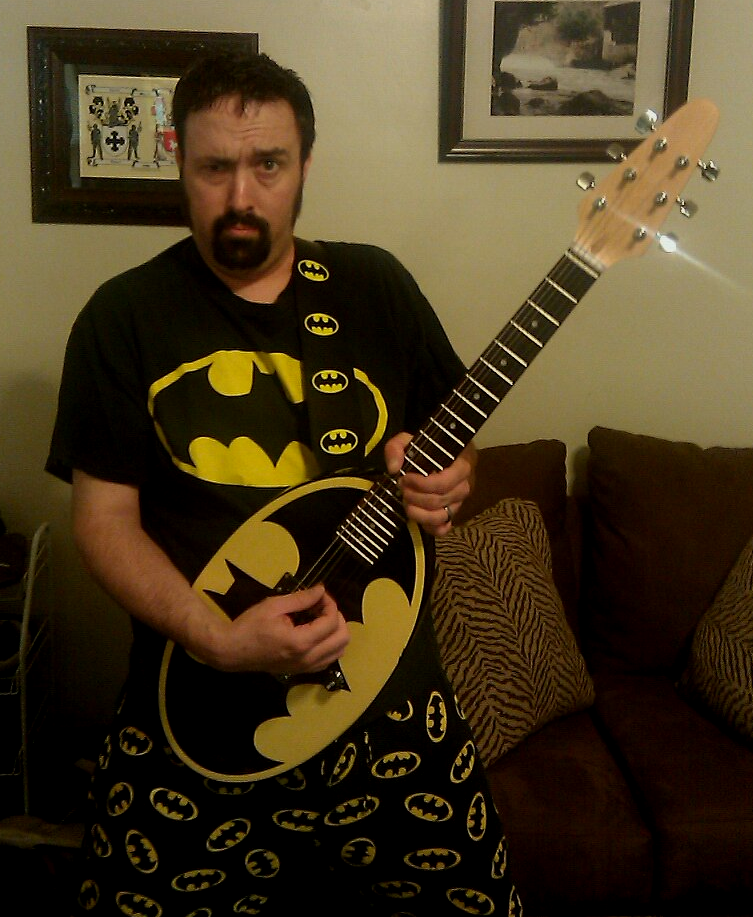 |
| Eric with the Bat guitar. Do you think there might be a theme going on here? |
ERiC AiXeLsyD writes:
Hello,
I was wondering if you guys would be able to help in tracking down the origin of this prize-guitar from Six Flags? I purchased mine on ebay a while ago, actually thanks to a commenter on your Superman logo guitar post. I waited until I saw one at a more reasonable price, as I had to have it due to being a huge Batman fan and to sheer goofiness. (I have started a rather odd collection.)
I really enjoy reading the Guitarz blog, and am amazed at the knowledge people seem to bring forth. All I know about this guitar is that it was apparently a prize at Six Flags. I have seen others online... different guitars, same concept (I've seen a V-shape and a Jackson/Ibanez 80s-looking one). They seem to go for around $75 or so if purchased at the parks.
Mine came with 1 extra string (looked like the high E), two allen keys, and a ridiculously oversized really thin red plastic pick.
All I know about it is from the text stamped on the back:
SIX FLAGS, INC.GRAND PRAIRIE, TX 75050MADE IN CHINABATMAN and all related characters and elements are trademarks of and © DC Comics.(s11)11-04
Is the s11 possibly a serial number? Maybe the model number? Is 11-04 a manufacturing date?
Is there a guitar manufacturer in China like the fabled Un-Sung/Silverstar factory in Korea that pumps out Galveston & possibly a slew of other brands?
Could this be a Cort? Why would anyone make a guitar and not put a logo on the headstock? Ha ha. I'd at least put a Batman logo, the DC comics logo, or a Six Flags logo there.
I had a guy at a local shop put in a new nut... what I thought was a lopsided nut was actually crooked and lopsided, so it needed replacing and a setup and it plays really well now, especially considering the low price-tag. Next it's getting a new pickup, and maybe some sort of homemade logo for the headstock!
Thanks in advance for your time and help!
Rock on!
-Eric
© 2011, Guitarz - The Original Guitar Blog - now in its 10th year!
Monday, 17 October 2011
Vintage Gibson Guitar Collection
guitarz.blogspot.com:


If you're feeling a bit flush this week, dole cheque come in early, hit the EuroMillions jackpot or made a stash from looting the local Apple store in the riots, you may be interested in acquiring an instant vintage guitar collection. Gibsons galore without the sweat.
This gleaming Aladdin's cave of vintage woodwork may well be right up your street. For a measly quarter of a million quid ($393,811.75 in funny money), you can adorn your den with someone else's lifetime of GAS. Go on. Hit that BIN button! You won't regret it! There are some interesting guitars there but, for someone asking that kind of dosh, you'd have thought he could have made the effort to take some better pictures.
David, sweating in overheated, tourist filled, indignados rioting on the doorstep, muggy, Barcelona
David, sweating in overheated, tourist filled, indignados rioting on the doorstep, muggy, Barcelona
© 2011, Guitarz - The Original Guitar Blog - now in its 10th year!
What guitar is Mike Oldfield playing in this video?
guitarz.blogspot.com:
Via the Guitarz Facebook page, reader Grégory Gutierez asks if we can identify the guitar being played by Mike Oldfield in this 1980 performance.
It looks rather like a Gibson L6-S that has been customised with new metal pickguard, pickups, and a metal plate on the headstock. Oldfield was known to play this model Gibson, and there are photos of him playing such a guitar, albeit without the modifications.
Shaped like a rather wide-bodied Les Paul, the L6-S was the first Gibson to have a 24-fret neck. It was designed by Bill Lawrence and was in production from 1973 through to 1979.
The L6-S Custom model (which is, I believe, what Oldfield played) features a chicken head 6-position rotary switch for pickup selection allowing for various series, parallel and out-of-phase tonal options.
Pictured here we see a Gibson L6-S "Midnight Special" which is currently listed on eBay with a very low starting price. It might be one to watch if you want a "budget priced" Gibson, assuming that the bidding does not go too crazy.
The Midnight Special mainly differed from the other models in the series by having a bolt-on neck.
G L Wilson
© 2011, Guitarz - The Original Guitar Blog - now in its 10th year!
Via the Guitarz Facebook page, reader Grégory Gutierez asks if we can identify the guitar being played by Mike Oldfield in this 1980 performance.
It looks rather like a Gibson L6-S that has been customised with new metal pickguard, pickups, and a metal plate on the headstock. Oldfield was known to play this model Gibson, and there are photos of him playing such a guitar, albeit without the modifications.
Shaped like a rather wide-bodied Les Paul, the L6-S was the first Gibson to have a 24-fret neck. It was designed by Bill Lawrence and was in production from 1973 through to 1979.
The L6-S Custom model (which is, I believe, what Oldfield played) features a chicken head 6-position rotary switch for pickup selection allowing for various series, parallel and out-of-phase tonal options.
Pictured here we see a Gibson L6-S "Midnight Special" which is currently listed on eBay with a very low starting price. It might be one to watch if you want a "budget priced" Gibson, assuming that the bidding does not go too crazy.
The Midnight Special mainly differed from the other models in the series by having a bolt-on neck.
G L Wilson
© 2011, Guitarz - The Original Guitar Blog - now in its 10th year!
Vintage & Rare guitar of the week: Prohaszka Silver Sparkle flat-top acoustic
guitarz.blogspot.com:
Balazs Prohaszka is a luthier from Hungary who has been building musical instruments since 1994. He has much experience of repairing and building guitars, violins, lutes and double basses so he surely knows his way around the anatomy of acoustic instruments. Prohaszka's fine guitars are made from exotic and choice tonal woods, and he believes that they are amongst the finest in the world. Employed as a senior craftsman with N. Ireland's Avalon Guitars (formerly Lowden Guitars), he builds approximately six or seven "personal" guitars in his own name each year during his spare time.
This Prohaszka silver-sparkle fronted flat-top acoustic guitar is currently being offered for sale via Vintage & Rare and is priced at £2600.00 (approx. €3101.00). The guitar has an original design that should find favour with electric players whilst still retaining the full acoustic body depth. I particularly like the "split" f-hole and the cut-out 6-in-a-line headstock which is quite elegant.
It's an instrument that you can imagine being played in the hands of the singer of a glitzy rock band. However, it might be considered sacrilege to subject a fine luthier-built instrument like this to the rock 'n' roll lifestyle where perhaps some cheaper generic electro-acoustic guitars would be better suited to the role. (Having said that, it doesn't look as if the Prohaszka Sparkle is actually fitted with any electronics, despite the design. I believe it is purely an acoustic guitar.)
G L Wilson
© 2011, Guitarz - The Original Guitar Blog - now in its 10th year!
Balazs Prohaszka is a luthier from Hungary who has been building musical instruments since 1994. He has much experience of repairing and building guitars, violins, lutes and double basses so he surely knows his way around the anatomy of acoustic instruments. Prohaszka's fine guitars are made from exotic and choice tonal woods, and he believes that they are amongst the finest in the world. Employed as a senior craftsman with N. Ireland's Avalon Guitars (formerly Lowden Guitars), he builds approximately six or seven "personal" guitars in his own name each year during his spare time.
This Prohaszka silver-sparkle fronted flat-top acoustic guitar is currently being offered for sale via Vintage & Rare and is priced at £2600.00 (approx. €3101.00). The guitar has an original design that should find favour with electric players whilst still retaining the full acoustic body depth. I particularly like the "split" f-hole and the cut-out 6-in-a-line headstock which is quite elegant.
It's an instrument that you can imagine being played in the hands of the singer of a glitzy rock band. However, it might be considered sacrilege to subject a fine luthier-built instrument like this to the rock 'n' roll lifestyle where perhaps some cheaper generic electro-acoustic guitars would be better suited to the role. (Having said that, it doesn't look as if the Prohaszka Sparkle is actually fitted with any electronics, despite the design. I believe it is purely an acoustic guitar.)
G L Wilson
© 2011, Guitarz - The Original Guitar Blog - now in its 10th year!
Sunday, 16 October 2011
Staccato MG bass, circa 1986, made from magnesium alloy and fibreglass
guitarz.blogspot.com:
This Staccato MG bass from 1986 is one of approx 200 guitars/basses built in the UK by Pat Townshend. I recall these guitars well from when they were first introduced, and remember seeing them at a music show in London, I'm guessing, in 1986. As I remember Chris Jagger (Mick's brother) was also involved in the company, and no doubt it was through his connections that these guitars were used by Mick Jagger and Bill Wyman in the Rolling Stones. Other endorsees included Gene Simmons of Kiss, and Motorhead's Lemmy (and if memory serves me correct, I saw Lemmy's bass exhibited at the above-mentioned music show).
The neck and centre body section is cast in one piece from magnesium alloy. Perhaps some more knowledgable readers can confirm this, but I seem to recall reading something to the effect that all the magnesium used in these guitars was filtered from sea water (magnesium being an element dissolved in sea water) and as such provides a material that made these guitars very environmentally friendly. Depending on the process employed to extract magnesium from water, that is.
The outer part of the body is made from fibreglass and seems to have been sculpted to provide for an ergonomic and body-fitting shape. Note that the strings are anchored at the headstock whilst the tuners are situated at the other end of the instrument behind the bridge. Pickups are double-bladed sealed units which are concealed within the magnesium centre body block with only the blades themselves protruding through to the front.
The fingerboard is made from an industrial plastic material and is fitted with 22 very low flat frets, which almost brings to mind the strange fretboard of the Lane Poor bass.
Unless my memory is playing more tricks on me, I believe Staccato offered basses and guitars with exchangable bodies / necks where the centre neck section could be swapped out for another guitar or bass (or converserly the body could be changed for say one in a different colour).
This eBay auction for this bass is finishing in 11 hours as I write; the starting price is $1,999 and Buy It Now price is $2,499.
G L Wilson
© 2011, Guitarz - The Original Guitar Blog - now in its 10th year!
This Staccato MG bass from 1986 is one of approx 200 guitars/basses built in the UK by Pat Townshend. I recall these guitars well from when they were first introduced, and remember seeing them at a music show in London, I'm guessing, in 1986. As I remember Chris Jagger (Mick's brother) was also involved in the company, and no doubt it was through his connections that these guitars were used by Mick Jagger and Bill Wyman in the Rolling Stones. Other endorsees included Gene Simmons of Kiss, and Motorhead's Lemmy (and if memory serves me correct, I saw Lemmy's bass exhibited at the above-mentioned music show).
The neck and centre body section is cast in one piece from magnesium alloy. Perhaps some more knowledgable readers can confirm this, but I seem to recall reading something to the effect that all the magnesium used in these guitars was filtered from sea water (magnesium being an element dissolved in sea water) and as such provides a material that made these guitars very environmentally friendly. Depending on the process employed to extract magnesium from water, that is.
The outer part of the body is made from fibreglass and seems to have been sculpted to provide for an ergonomic and body-fitting shape. Note that the strings are anchored at the headstock whilst the tuners are situated at the other end of the instrument behind the bridge. Pickups are double-bladed sealed units which are concealed within the magnesium centre body block with only the blades themselves protruding through to the front.
The fingerboard is made from an industrial plastic material and is fitted with 22 very low flat frets, which almost brings to mind the strange fretboard of the Lane Poor bass.
Unless my memory is playing more tricks on me, I believe Staccato offered basses and guitars with exchangable bodies / necks where the centre neck section could be swapped out for another guitar or bass (or converserly the body could be changed for say one in a different colour).
This eBay auction for this bass is finishing in 11 hours as I write; the starting price is $1,999 and Buy It Now price is $2,499.
G L Wilson
© 2011, Guitarz - The Original Guitar Blog - now in its 10th year!
Silvertone 1445L - Mosrite-inspired solidbody from 1969
guitarz.blogspot.com:
Again, I don't have too much information on this 1969 Silvertone guitar. Despite having seen better days it's still quite a beauty. The pickup covers have been removed; the seller says they were taken off because they were rusty - I still would have liked to have seen them in place on the guitar. The Silvertone brand was sold through Sears, Roebuck and Company stores with guitars being supplied by a number of manufacturers, most notably Danelectro. I'd hazard a guess at this particular model being of Japanese origin. The Japanese were very fond of imitating Mosrite guitars, and the headstock looks very similar to that found on early Yamaha SG-2 and SG-3 guitars, for instance.
This auction is finishing in approximately three and a half hours at the time of writing with bidding currently at $250.
G L Wilson
Additional: sold for $250.
© 2011, Guitarz - The Original Guitar Blog - now in its 10th year!
Again, I don't have too much information on this 1969 Silvertone guitar. Despite having seen better days it's still quite a beauty. The pickup covers have been removed; the seller says they were taken off because they were rusty - I still would have liked to have seen them in place on the guitar. The Silvertone brand was sold through Sears, Roebuck and Company stores with guitars being supplied by a number of manufacturers, most notably Danelectro. I'd hazard a guess at this particular model being of Japanese origin. The Japanese were very fond of imitating Mosrite guitars, and the headstock looks very similar to that found on early Yamaha SG-2 and SG-3 guitars, for instance.
This auction is finishing in approximately three and a half hours at the time of writing with bidding currently at $250.
G L Wilson
Additional: sold for $250.
© 2011, Guitarz - The Original Guitar Blog - now in its 10th year!
Saturday, 15 October 2011
Pre-war, French-made "Pineapple" guitar
guitarz.blogspot.com:
I'm afraid I have virtually zero information to give you about this French pineapple guitar other than it looks to be a nylon strng instrument (although it originally had a trapeze tailpiece which would imply folk guitar rather than classical guitar) and is supposedly pre-war French (2nd World War, I believe).
Its shape echoes that of the pineapple ukulele. I've not seen a pineapple-shaped guitar before, although we have previously looked at an egg-shaped acoustic guitar.
This guitar does require some attention and as such is being auctioned on eBay UK as a project with a starting price of £50.
G L Wilson
Additional: We believe it is a Hawaiian guitar - see the comments below this post.
© 2011, Guitarz - The Original Guitar Blog - now in its 10th year!
I'm afraid I have virtually zero information to give you about this French pineapple guitar other than it looks to be a nylon strng instrument (although it originally had a trapeze tailpiece which would imply folk guitar rather than classical guitar) and is supposedly pre-war French (2nd World War, I believe).
Its shape echoes that of the pineapple ukulele. I've not seen a pineapple-shaped guitar before, although we have previously looked at an egg-shaped acoustic guitar.
This guitar does require some attention and as such is being auctioned on eBay UK as a project with a starting price of £50.
G L Wilson
Additional: We believe it is a Hawaiian guitar - see the comments below this post.
© 2011, Guitarz - The Original Guitar Blog - now in its 10th year!
Marlin PB-26 Bass - a 1960s Japanese hollowbodied pre-cursor to B.C. Rich perhaps?
guitarz.blogspot.com:
This Japanese-made Marlin PB-26 bass circa 1968 is no relation to the Marlin brand that issued a range of colourful and cheap Chinese-made plywood-bodied Strat and P-Bass copies in the late 1980s. Put those out of your mind; we shall endeavour not to mention them again.
As with other guitars and basses coming out of Japan they were marketed with different brandnames. This same model was also available under the "Idol" brandname. There was also a 6-string guitar sibling, the PA-26, complete with vibrato. They would all have been built at the same factory, possibly the now legendary Matsumoku factory although I am not able to verify this for certain.
You have to wonder if some of B.C. Rich's designs were inspired by instruments such as this. It just goes to show that some ideas are not as original as you might at first think.
The seller assures us that this is one of the finest basses he has ever played (which begs the question why is he selling it?) and it is currently listed on eBay with a Buy It Now price of $1,899.99.
Thanks to Oinque guitars for pointing this one out to us!
G L Wilson
© 2011, Guitarz - The Original Guitar Blog - now in its 10th year!
This Japanese-made Marlin PB-26 bass circa 1968 is no relation to the Marlin brand that issued a range of colourful and cheap Chinese-made plywood-bodied Strat and P-Bass copies in the late 1980s. Put those out of your mind; we shall endeavour not to mention them again.
As with other guitars and basses coming out of Japan they were marketed with different brandnames. This same model was also available under the "Idol" brandname. There was also a 6-string guitar sibling, the PA-26, complete with vibrato. They would all have been built at the same factory, possibly the now legendary Matsumoku factory although I am not able to verify this for certain.
You have to wonder if some of B.C. Rich's designs were inspired by instruments such as this. It just goes to show that some ideas are not as original as you might at first think.
The seller assures us that this is one of the finest basses he has ever played (which begs the question why is he selling it?) and it is currently listed on eBay with a Buy It Now price of $1,899.99.
Thanks to Oinque guitars for pointing this one out to us!
G L Wilson
© 2011, Guitarz - The Original Guitar Blog - now in its 10th year!
Friday, 14 October 2011
Amazing Eko 295 - 1960s original and 2000s reissue
I was making some research on Eko for my previous post, and thought I would check the new Eko website, and I figured out that they discreetly but steadily reissue all their vintage models - without big announcement in guitar magazine and reviews on professional guitar blogs...
I discovered this crazy guitar, the 295, a so far extremely rare semi-hollow version of the classic Eko 700 model - a dream guitar for all those bored with the classic designs. The reissue model differs from the original, mostly with its humbuckers that are much likely an improvement, and the stop-tail replacing the cool but probably unsteady tremolo.
Strangely the eccentric sound-holes have been modified, and not for the better, and the rotary switch is now a standard one - guitar makers, please reintroduce rotary switches, they are so much cooler and practical (I actually look for a 5 positions one for my next guitar project, anybody knows where to get one?)
You have like usually the best article about Eko 295 on fetishguitars.com and the vintage photos come from guitarage.nl, another good resource for alternative guitar lovers - and you can find the contemporary version on ekoguitars.it. For me I still favor the Eko Kadett 67, it's on my list of must-have guitars, and I'm happy to now have the chance to get a contemporary version of it, for a guitar is meant to be played and I wouldn't be comfortable with a museum piece (and I also think, contrarily to common belief, that most nowadays guitars are better that they used to be).
Strangely the eccentric sound-holes have been modified, and not for the better, and the rotary switch is now a standard one - guitar makers, please reintroduce rotary switches, they are so much cooler and practical (I actually look for a 5 positions one for my next guitar project, anybody knows where to get one?)
You have like usually the best article about Eko 295 on fetishguitars.com and the vintage photos come from guitarage.nl, another good resource for alternative guitar lovers - and you can find the contemporary version on ekoguitars.it. For me I still favor the Eko Kadett 67, it's on my list of must-have guitars, and I'm happy to now have the chance to get a contemporary version of it, for a guitar is meant to be played and I wouldn't be comfortable with a museum piece (and I also think, contrarily to common belief, that most nowadays guitars are better that they used to be).
© 2011, Guitarz - The Original Guitar Blog - now in its 10th year!
Vintage modified Höfner 182 bass
guitarz.blogspot.com:
Dave Coulson
© 2011, Guitarz - The Original Guitar Blog - now in its 10th year!
My uncle gave me a bass which he'd informed me a friend had made for him when he was in the army in the late '60s/early '70s... this is it. I was mildly surprised and rather pleased to see it was in actual fact a (very badly) modified Hofner 182 Solid. The neck was held on by standard (and odd) wood screws, the 'strap button' on the upper bout was also a wood screw and the scratchplate was clearly a home job. The pickups (one broken) I've never seen before. The finish looks lovely, far better than the colours (or the vinyl) that I've seen on these basses before - I'm guessing it's been stripped and varnished, but if so it has been very well done. I'm setting about restoring it, but I won't touch the finish.
Dave Coulson
© 2011, Guitarz - The Original Guitar Blog - now in its 10th year!
Thursday, 13 October 2011
Guyatone LG-40 guitar made in Japan circa 1959
guitarz.blogspot.com:
This Guyatone LG-40 is quite an ordinary guitar compared to other models from the Guyatone range such as the super sexy sleek LG-1200 or the LG-120 with its rotating neck pickup. However, this slab-bodied instrument is not without its charms; don't you just love those almost oval-shaped pickups? Binding on both neck and body adds a touch of class. Believed to be from the late 1950s, this guitar was probably considered to be state of the art uber-cool back in the day.
Currently listed on eBay UK with a Buy It Now price of £300.
G L Wilson
© 2011, Guitarz - The Original Guitar Blog - now in its 10th year!
This Guyatone LG-40 is quite an ordinary guitar compared to other models from the Guyatone range such as the super sexy sleek LG-1200 or the LG-120 with its rotating neck pickup. However, this slab-bodied instrument is not without its charms; don't you just love those almost oval-shaped pickups? Binding on both neck and body adds a touch of class. Believed to be from the late 1950s, this guitar was probably considered to be state of the art uber-cool back in the day.
Currently listed on eBay UK with a Buy It Now price of £300.
G L Wilson
© 2011, Guitarz - The Original Guitar Blog - now in its 10th year!
Here's another guitar to identify ... Any ideas?
guitarz.blogspot.com:
Guitarz reader Bobby writes:
It's possible that the whole guitar was built from parts, although the fact that this isn't a bolt-on neck job, but instead it is glued into the body (or else is a neck-through which I kind of doubt) would make this quite a mean feat for the casual DIY luthier.
This guitar has a very 1960s look to it, so I'm guessing that is when it dates from. The headstock shape is reminiscent of those on certain Vox guitars of the period, but is this original to the neck or has it been re-shaped? And then there's those tuners ... I've seen those somewhere else, surely?
So, do any of you guys out there recognize this axe or have any clues as to its provenance? Pleae let us know in the usual way via the comments. Thanks.
G L Wilson
© 2011, Guitarz - The Original Guitar Blog - now in its 10th year!
Guitarz reader Bobby writes:
I bought a strange guitar a couple of years ago off of ebay, but am struggling to find any information on it...Well, seeing as it has a Höfner pickup my first question has to be is there any possibility it could be a Höfner? It's certainly not a model that I'm aware of, but I guess another possibilty is that it's been heavily modified. The pickguard does look to be homemade, and the blue finish is almost certainly a piece of self customisation.
The pickup is a Höfner, but I can't find a similar/same one online in Google searches. It's a very thin body, all one piece with the neck.... Do you or your readers have any ideas?
It's possible that the whole guitar was built from parts, although the fact that this isn't a bolt-on neck job, but instead it is glued into the body (or else is a neck-through which I kind of doubt) would make this quite a mean feat for the casual DIY luthier.
This guitar has a very 1960s look to it, so I'm guessing that is when it dates from. The headstock shape is reminiscent of those on certain Vox guitars of the period, but is this original to the neck or has it been re-shaped? And then there's those tuners ... I've seen those somewhere else, surely?
So, do any of you guys out there recognize this axe or have any clues as to its provenance? Pleae let us know in the usual way via the comments. Thanks.
G L Wilson
© 2011, Guitarz - The Original Guitar Blog - now in its 10th year!
Wednesday, 12 October 2011
Vintage Klira in red mosaic finish
Nothing exceptional here - just a good old cool vintage Klira in fancy finish, but I take the opportunity to remind some facts. First, about Klira: it was an underrated guitar brand from West-Germany that unfortunately left no online archives. Like many German guitar companies, it's originated in the areas of Markneukirchen about which I talked in a previous post - it's more precisely from Schönbach that is nowadays in Czech Republic, starting as a bowed instruments company in the late 19th century.
Like several other companies - such as Höfner - after the WWII it relocated in Bavaria where it started to produce Schlaggitarren - these great hollow body guitars, then solid body guitars, including this budget one-pickup model, unbranded and sold by mail order. Klira disappeared in the early 1980s, unable to cope with new competitors from Asia.
Another thing I evoked before and might be still difficult to grasp for our American or younger readers, is that before the explosion of guitar music - then guitar market - the most popular instrument in Europe was the accordion. It is now so out of fashion that it's hard to imagine that it was once the icon of modernity in music - you even had electric accordions with effects and I know some accordion avant-garde music that would make great science-fiction soundtracks. Before jazz and blues became the root of the best 20st century music, Europe had already surrender for a long time to fusion american sounds, and for example had danced avidly to Argentinian tango, that was mostly accordion-based in its European versions.
So when guitar took over, several music instrument companies didn't shift from violin/cello to guitars like Gibson or Klira, but from accordion like swedish Hagström or italian Eko, and since they were great at making synthetic flashy, patterned, glossy, sparkly finishes, they kept doing it on their guitars. It's been so fashionable that even Klira, in spite of its more classic background, started to do the same - though they still used wooden bodies instead of more usual plywood for these kind of models. Look at this faux-mosaic effect: you still have a lot of these irregular mosaics on 1950s/1960s modern murals in European institutions, it looks so foreign now!
Oh, and the trem is cool too!
© 2011, Guitarz - The Original Guitar Blog - now in its 10th year!
guitarz.blogspot.com
One-off 1970s Ibanez Artist made from solid brass is quite literally Heavy Metal
guitarz.blogspot.com:
Wow! I mean we've seen metal guitars before, but not any made from solid brass. That's right, solid, not plated. I couldn't say whether or not the guitar body is chambered, but weighing in at a whopping 70 lbs it's possible that this one-off brass Ibanez Artist IS solid all the way through! Imagine what that must feel like... and you thought a Les Paul was heavy! Despite the weight, apparently it IS fully playable and has recently been professionally set up. Looking at the condition of the body with scrapes and dings it looks like it may have been used over the last 4 decades too.
But "WHY?" you may well be asking. Apparently it was created as a centre piece for the unveiling of the Ibanez Artist line at NAMM sometime in the mid 1970s. (Has anyone got a more specific date for me here?)
Other than unusual choice of body material, specs are: 25" scale, 1 11/16" nut width, ebony fingerboard, Flying Fingers humbuckers, active 3-band equalizer.
This one of a kind guitar is currently listed on eBay with a Buy It Now price of $24,999.95.
Thanks to Jason Moody for bringing this guitar to my attention.
G L Wilson
© 2011, Guitarz - The Original Guitar Blog - now in its 10th year!
Wow! I mean we've seen metal guitars before, but not any made from solid brass. That's right, solid, not plated. I couldn't say whether or not the guitar body is chambered, but weighing in at a whopping 70 lbs it's possible that this one-off brass Ibanez Artist IS solid all the way through! Imagine what that must feel like... and you thought a Les Paul was heavy! Despite the weight, apparently it IS fully playable and has recently been professionally set up. Looking at the condition of the body with scrapes and dings it looks like it may have been used over the last 4 decades too.
But "WHY?" you may well be asking. Apparently it was created as a centre piece for the unveiling of the Ibanez Artist line at NAMM sometime in the mid 1970s. (Has anyone got a more specific date for me here?)
Other than unusual choice of body material, specs are: 25" scale, 1 11/16" nut width, ebony fingerboard, Flying Fingers humbuckers, active 3-band equalizer.
This one of a kind guitar is currently listed on eBay with a Buy It Now price of $24,999.95.
Thanks to Jason Moody for bringing this guitar to my attention.
G L Wilson
© 2011, Guitarz - The Original Guitar Blog - now in its 10th year!
Tuesday, 11 October 2011
Kimberly Fire Bird 1960s Japanese thinline
guitarz.blogspot.com:
The wildly exaggerated design of this 1960s Japanese Kimberly Fire Bird makes for quite a glorious guitar, enhanced by the green burst finish. I'm sure this was the effect that MusicVox intended with their retro-themed guitars with exaggerated body horns.
Unfortunately there are just 6 hours left for this auction to run on eBay, so by the time some of you read this the guitar will be sold. The bidding at the time of writing is at $760. It's a shame that the vibrato arm appears to be missing.
We have looked at a couple of Kimberly guitars before (here and here) and other than one of them being a re-branded Teisco, I am afraid I am unable to tell you much more about the brand.
Thanks to Tom Naumann for bringing this guitar to my attention.
G L Wilson
Additional: The eventual winning bid was $2,225. Wow!
© 2011, Guitarz - The Original Guitar Blog - now in its 10th year!
The wildly exaggerated design of this 1960s Japanese Kimberly Fire Bird makes for quite a glorious guitar, enhanced by the green burst finish. I'm sure this was the effect that MusicVox intended with their retro-themed guitars with exaggerated body horns.
Unfortunately there are just 6 hours left for this auction to run on eBay, so by the time some of you read this the guitar will be sold. The bidding at the time of writing is at $760. It's a shame that the vibrato arm appears to be missing.
We have looked at a couple of Kimberly guitars before (here and here) and other than one of them being a re-branded Teisco, I am afraid I am unable to tell you much more about the brand.
Thanks to Tom Naumann for bringing this guitar to my attention.
G L Wilson
Additional: The eventual winning bid was $2,225. Wow!
© 2011, Guitarz - The Original Guitar Blog - now in its 10th year!
1957 Gibson Les Paul Special
This guitar is sold on eBay as a genuine 1957 Gibson Les Paul Special (with serial number 74008), and it does like like one - same P90s, pickguard, characteristic yellow finish...
But I've never seen such pickguard and stoptail - not on a Les Paul Special nor any other guitar - anybody has information about this?
Bertram
© 2011, Guitarz - The Original Guitar Blog - now in its 10th year!
Subscribe to:
Comments (Atom)

